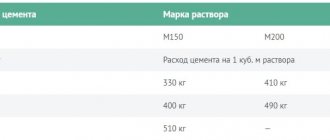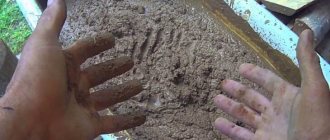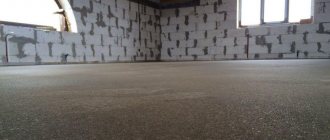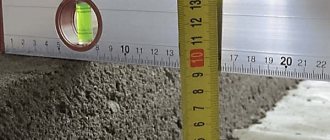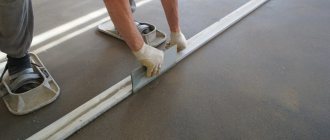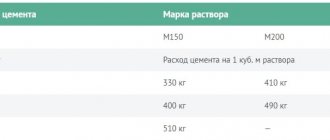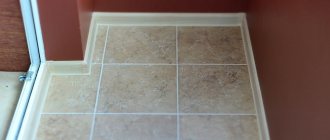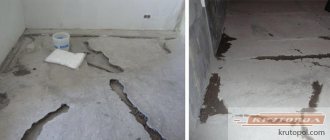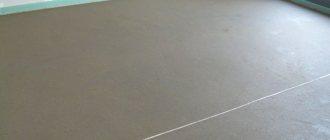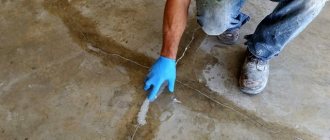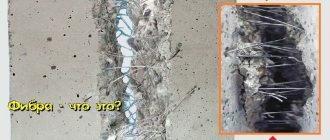When purchasing an apartment, the owners dream of finding a flat floor surface in the new room. However, the reality is that most houses are delivered with a rough finish, which, naturally, unevenness on the floors is inevitable. But there is no reason to be upset if additional work needs to be done on the premises of the purchased apartment. This is a great opportunity to make renovations to your liking. A floor screed solution will help ensure the required flatness of the floor surface. The proportion of components used affects the performance properties.
Screed mortar - what is needed to prepare it
Unfortunately, not everyone has an idea of how to make a solution for pouring a floor, as well as what ingredients will be needed to complete the work. At first glance, the questions seem simple. However, people cannot always give the correct answer. Of the many construction operations, one of the most critical is floor screeding. The brand of the solution is determined by the ratio and type of components used.
Professional builders know how to prepare a cement mortar for pouring a floor that meets the requirements of the standard.
They use the following ingredients:
- Portland cement. It is an astringent component. The brand of screed mortar depends on the marking and amount of cement used;
- medium coarse sand. It is pre-cleaned from various types of impurities. Used in the mixture as a filler;
A high-quality floor screed solution is of great importance when carrying out repair or construction work.
- water. It is added in portions to the working mixture, including the solution for screeding heated floors. The proportions are determined experimentally;
- plasticizers. They increase the fluidity and strength characteristics of the working mixture. They are divided into types depending on the effectiveness of the impact;
- fiber fiber. Not a required component. However, its introduction prevents plastic shrinkage and cracking of the massif.
Let us dwell in more detail on the percentages of the ingredients included in the working mixture.
Scope of use
The scope of application is determined not only by the composition, but also by the grade of cement in terms of compressive strength.
The higher it is, the more reliable the structures and the longer their service life. Therefore, when choosing which cement is better: D0 or D20, you need to take into account the purpose and conditions of use of the objects. Among the most common are:
- M400 D0
It is characterized by high frost resistance, average shrinkage deformations and hardening rates. It is used for the manufacture of prefabricated and monolithic structures in private construction and the construction of industrial facilities. - M400 D20
is characterized by average shrinkage deformations, frost resistance and hardening rate. Used for the production of various concrete structures. - M500 D0
is characterized by high frost resistance and durability. Therefore, it is used in the construction of large industrial structures, bridge structures, airfield pavements and during various restoration work. - M500 D20
has average frost resistance and hardening. Serves as a raw material for casting monolithic products, in private construction and decoration.
Proportions of cement and sand for floor screed
To ensure the strength of the finishing coating, it is necessary to properly cement the rough base, which has the necessary strength margin. To solve this problem, it is important to determine what proportion of cement and sand for the screed is optimal, as well as how to make the mortar for the screed. We will try to give a clear answer to these questions.
The optimal proportions of cement and sand for screed are 1:3. You should be guided by the indicated ratio, and also pay attention to some points:
- it is not advisable to add cement in increased quantities, since excess Portland cement causes the formation of cracks;
- it is possible to introduce an increased volume of filler while reducing the loads acting on the floor without losing the quality of the base;
- an increased grade of cement for floor screed allows you to increase the strength and service life of the cemented base;
- It is necessary to add water to the mixture gradually until the required plasticity is achieved, maintaining a 2:1 ratio with cement.
To ensure the specified strength properties of the base and surface quality, experts recommend using Portland cement grade M300 and higher.
Sand, which is used in the preparation of mortar for floor screed, can have fractions of different sizes
The best option…
for the street
Cement-based solutions and mixtures are actively used to perform various street works. In each specific case, you should opt for a specific type and brand. The greatest interest among Internet users is a binder suitable for pouring foundations and fence supports.
for pouring the foundation when building a house, what brand?
For the construction of foundations for objects for various purposes PC M400-500 is most often used , PC M600 is used for the construction of special-purpose objects. But these recommendations are general. In addition, there are certain tips for using cement and concrete:
- For the production of concrete M100-150 , used for arranging the foundations of garages, outbuildings and small wooden houses, the use of M300 binder will be required.
- The basis of concrete M200 is cement M300 or 400 . Brand M200 is used for arranging the foundations of one- and two-story houses made of relatively light materials.
- Concrete grades M250 based on cement M400 and M300 , for the preparation of which binder M400 or 500 is used, is used to form the foundations of houses with several floors.
- Concrete M400 , for the preparation of which binder M500 or 600 is used, is used for arranging the foundations of multi-story buildings.
Portland cement M500. Photo Asia Cement
Preparation of concrete for foundations requires compliance with the following proportions : 1 part PC M400; 1.9 clean washed sand without clay inclusions; 3.7 crushed stone and filtered water or 1 part PC M500; 2.4 sand; 4.3 crushed stone and water.
The process of making concrete is a critical stage of work. For the production of concrete mixtures, manual and mechanized methods are used ; it is possible to order concrete at the mortar unit of the plant. For manual kneading, you can use any sealed container; you will also need a wide and bayonet shovel. The concrete preparation process is carried out as follows . Cement and sand are poured into the container. The components are thoroughly mixed with a shovel until smooth. The mixture is poured with water, everything is mixed. When the solution is ready, crushed stone is added to it. All components are mixed again, after which the concrete is ready for pouring.
Crushed stone for concrete mortar for the foundation. Baucentr Photos
Mixing the components in a concrete mixer should be carried out following a simple order : first, coarse-grained materials are poured, then fine-grained ones, and finally plasticizing additives are added to the composition. The technology is as follows, it is necessary:
- pour crushed stone into a rotating container, repeat this operation with sand;
- load the cement and wait 2-3 minutes until the mixture has a homogeneous consistency;
- add the required amount of water with plasticizer;
- stir the solution for 3-5 minutes, the solution is ready for use.
Rating
When choosing cement for a certain type of work, you must follow the recommendations. But each performer has his own opinion regarding the best binder option, which may not coincide with the advice of experts.
for fence posts, proportions
Portland cement M400. Vimos Photos
The supports of concrete, brick, metal and other types of fences must be securely fixed; for this purpose, cement mortar . The pillars, being below the soil level, experience constant wind loads and precipitation. Therefore, it is recommended to use Portland cement M400 to prepare the solution. You will also need quarry or river sand, crushed stone or gravel with a size of 5-10 or 10-20 mm. To fill the pillars, you need to mix 1 part cement, 2 sand, 3 coarse filler and 0.5 water. The technology for installing pillars is as follows:
- marking the territory;
- formation of holes at least 0.5 meters deep with a garden drill; in heaving soils - at least 1-1.2 meters;
- installing a post in a hole, checking verticality with a building level;
- filling the hole with crushed stone to 2/3 of the depth and thoroughly compacting it;
- mixing the solution;
- filling the hole while simultaneously compacting the solution until moisture appears on the surface;
- let the concrete harden;
- After 28 days, perform ironing.
Rating
Choosing the best binder for pouring fence posts depends on the type of structure. Therefore, despite the recommendations, performers use other brands of cement.
for blind area
The arrangement of blind areas is carried out using cement-sand and concrete mixtures . The market is replete with ready-made solutions, but it is possible to make the material yourself. to use PVA glue as a performance-improving additive . Cement blind areas perform protective and decorative functions . The width of the blind area should not be less than 1 meter, the thickness for normal soils should be 20-30 cm, heaving soil - 50 cm, the thickness of the above-ground part should exceed 5 cm. Slope for subsiding soils - 5%, normal - 1-2 %.
Cement M500. Roscement Photos
The blind area protects the base of the building from precipitation and mechanical damage, ensures strength and durability. A properly equipped blind area provides protection against mold and mildew that can form in the house. The blind area provides ease of movement around the house. But to achieve these functions, it is necessary to arrange the blind area correctly.
For the blind area it is possible to use several grades of cement: M200, M300, M400 and M500 . The first brand has minimal frost resistance and is suitable for regions with minor temperature changes . Brands M300 and 400 are suitable for central Russia, 500 - for cold regions .
Requirements apply to other components of the solution: sand without impurities, river crushed stone up to 20 mm, running water. It is possible to use special additives (expanded clay or PVA) and gravel as plasticizers. The proportions for the mortar that builders adhere to are as follows: cement - 1 part; sand - 3; crushed stone - 4 and water - 1/2. The components are mixed with a shovel or in a concrete mixer, the solution is poured into the prepared formwork and evenly distributed around the perimeter. The detailed sequence of steps is as follows:
- preparatory work , including the purchase of materials, preparation of tools, containers and special clothing;
- preliminary work , which involves cleaning the area, leveling the surface, forming a cushion from bulk material, installing formwork;
- water is poured into a concrete mixer or container, cement is added, and the solution is mixed until it becomes “milk”;
- crushed stone is poured into the solution, the components are mixed;
- you need to wait 30 minutes and mix the mixture again, add sand, achieve a uniform consistency;
- the composition is poured into the formwork, leveled with tools, and sprinkled with water.
To give the structure an aesthetic appearance, strengthen the blind area and enhance the waterproofing properties, it is possible to decorate the surface by painting with enamels or polymer paints for concrete surfaces, ironing, impregnation, and laying paving slabs.
Rating
To construct a blind area, it is possible to use several grades of cement. As a result, performers choose different options, and they can then vote for one of them.
for floor screed
A cement floor screed can act as a base for a finishing coating or serve as one. The screed performs several functions: it levels the surface, creates slopes if necessary, raises the floor level, and improves heat and sound insulation characteristics. There are several types of screeds:
- self-leveling , for the arrangement of which ready-made packaged industrial material is used;
- dry is equipped with special hard materials and, in accordance with special technology, is able to level out minor unevenness;
- cement-sand is used to level the surface under linoleum, boards, parquet, tiles and other types of finished flooring.
Portland cement M500. Castorama Photos
The thickness of the cement-sand screed is a factor on which the strength and durability of the structure depends, as well as the required number of components. The minimum thickness of the screed in accordance with regulatory documents is 40 mm. But there are also recommendations regarding this issue:
- if the base is a reinforced concrete slab, then the indicator should not be less than 50 mm;
- pouring onto a waterproofing layer, installation on wooden floors without reinforcement - at least 70 mm;
- Expanded clay or sawdust is used as a filler - at least 100 mm;
- the use of plasticizers makes it possible to reduce the thickness to 30-35 mm;
- when located in the thickness of the utility screed, its thickness on top of cables, wires, pipes should be at least 25-30 mm.
To prepare a cement-sand screed, it is recommended to choose Portland cement M400 or 500 D0 . You will also need sifted and washed sand, clean water, reinforcing polypropylene fiberglass with a thickness of 12-18 mm, metal welded mesh, and a plasticizer. The ratio of components depends on the type of screed : semi-dry or classic. To obtain a semi-dry screed solution, you will need 1 part of cement and 4 (to obtain a mixture of grade M150) or 6 parts of sand (M200+). Classic floor screed refers to the “wet” method of leveling the surface. A classic screed, unlike a semi-dry one, is sealed with a significant amount of water. The ratio of sand and cement is 1 to 3, the strength of the screed will correspond to the M300 grade. But this type of structure is subject to shrinkage during hardening.
Rating
The choice of cement brands for screed construction is small, so perhaps site visitors have their own recommendations and opinions regarding the best binder option.
for bricklaying
Masonry mortars are a type of mortar, the composition and manufacturing technology of which is regulated by GOST, SP, SNiPs. The basis for masonry mortars can be various binders. In private residential construction, mortars based on Portland cement (PC) grades M400 and M500 are most often used. The following are best suited for preparing masonry mortars:
- PC M400 D0 and M400 D5 . Compressive strength reaches 40 MPa. The brands are best suited for the construction of small houses.
- PC M500 D0. Compressive strength - no more than 50 MPa. Mixtures based on M500 D0 exhibit slight shrinkage during hardening, which reduces the likelihood of cracking. M500 is most often used in the construction of buildings subject to increased loads.
Cement. Photo by YuzhUralPBK
In addition to the binder, the constituent elements of masonry mortars are:
- Sand . It is recommended to use sand that meets the requirements of GOST 8736-2014. Washed or seeded quarry sand, cleared of silty river inclusions. The use of contaminated sand leads to a decrease in the quality of the solution. The maximum grain size is 2.5 mm.
- Water . It is possible to use drinking water. The use of process water or water from natural reservoirs requires testing for the presence of impurities, the presence of which may negatively affect the quality of the solution. For mixing, use water at room temperature.
- Coloring pigments are used to obtain solutions of a certain color.
- Plasticizers increase the characteristics of the mortar, improve workability, and make it easier to work with cement. Increased plasticity can be achieved through the use of detergents: washing powder or dishwashing liquid.
- Antifreeze components are used to ensure normal hydration in low temperature conditions.
When preparing solutions, the following proportions should be adhered to:
| Brand of solution, application | Cement brand | Component proportions, Cement:Sand |
| M50 is used for masonry in low-rise construction | M400 | 1:7,4 |
| M75 is a universal material that is used for brick and block masonry of partitions and external walls | M400 | 1:5,4 |
| M500 | 1:6,7 | |
| M100 is used in the construction of multi-storey residential buildings and industrial facilities | M400 | 1:4,3 |
| M500 | 1:5,3 | |
| M150 is highly durable and is therefore used for masonry | M400 | 1:3,25 |
| M500 | 1:3,9 |
Rating
Cement mortars for brickwork are subject to fewer requirements than for more critical tasks. But saving is still not recommended, so you should choose the best and most affordable brands. However, the opinions of visitors to our site may not coincide with this statement.
for swimming pool
The pool bowl is a hydraulic structure subject to a number of influences : waves at the water's edge, water hardness and temperature changes. Thus, concrete for a swimming pool must have increased characteristics of water resistance, frost resistance, compressive and tensile strength, and density. Hydrophobic cement can meet the requirements Most enterprises produce cement to order for legal entities, so it is produced in large quantities.
It is possible to make a hydrophobic solution with your own hands. To do this, you will need Portland cement M400 or M500 and a hydrophobic additive, which is introduced into the composition at the stage of mixing the material: KON or “PLASTIPRUF”, a hydrophobic additive for concrete in the form of a dry powder. It is important to strictly follow the instructions and adhere to the dosage specified by the manufacturer.
Rating
Choosing cement for a pool involves both determining the optimal brand and type. It is possible to purchase a special-purpose binder or save money and make a composition based on available Portland cement.
for paving slabs
Paving slabs are one of many cement-based products. The components of the solution and their proportions affect the properties of the product. Therefore, the choice of cement must be taken with care. The standard is to use the M500 brand. But an important criterion for analysis is color. To make tiles, 2 types of cement are used: standard gray and special white.
White cement. Photo by LafargeHolcim
The first is suitable for ordinary paths. The second should be chosen for arranging paths with a thoughtful design. The use of white cement allows you to give the tiles any color. This type of binder is resistant to cold; as a result, the material does not lose its properties in winter frosts. The proportions of the components, tile manufacturing technology and other information are presented in detail in a separate article.
Rating
M500 grade cement, which is the best option for paving slabs, is sold at a fairly high cost. Therefore, many performers prefer to opt for other options. Tell us which brand you choose in the survey below.
for walls
Plaster mortars containing cement are a popular material for finishing the external and internal walls of buildings for various purposes: residential, administrative, industrial. are used for finishing . The choice is made depending on future operating conditions. Solutions can be simple or complex. The former use one binder, the latter, in addition to cement, also use other binders, most often lime. Cement mortars for plaster are distinguished by their versatility, which allows them to solve a number of problems:
- rough leveling of walls, allowing to eliminate unevenness and height differences, cracks;
- pre-finishing allows you to create a basis for applying paint, interior plaster, wallpaper;
- arrangement of additional sound and heat insulation;
- protection of the surface from various negative influences: precipitation, ultraviolet radiation, etc.
Cement M400. Photo Petrovich
Cement-based plaster is popular because... has a number of positive characteristics:
- good strength , exceeding the characteristics of other plasters;
- resistance to moisture due to the presence of special water-repellent additives;
- good adhesion to the base ; in this parameter, cement plaster is second only to gypsum-based mixtures;
- resistance to sudden temperature changes.
To prepare plaster, cement M400 and M500 is usually used. Brand M400 is used by private developers. Cement M500 is intended for plastering surfaces that are subject to serious influences. Quarry sand washed from silt by hand or cleared of clay must first be sieved; the grain size for covering should be 1.25 mm, for all other layers - 2.5 mm. To prepare the plaster, it is recommended to use dry aggregate. Water from the drinking pipeline must not contain impurities. Depending on the selected grade of cement and the proportions of the components, it is possible to obtain different grades of solutions for the formation of multilayer coatings:
- Spray . To apply this layer, a liquid solution is used. The layer thickness when applied manually should be 3-5 mm. To prepare the solution you will need 1 part M400 cement and 2.5-4 parts sand.
- Soil . The solution should be denser than in the first case, thickness - 7-9 mm. The composition of the mixture is 1 part cement and 2-3 parts sand.
- The covering is a thin layer (2-5 mm), which is applied over hardened soil. In this case, 1 part of cement is mixed with 1-1.5 parts of sand.
Spray and soil form on the walls of utility rooms. The most common option for plastering interior and exterior walls is to apply three coats.
There is a wide range of dry cement mixtures on sale, which contain additives that improve individual characteristics:
- quartz sand and diabase flour increase resistance to acidic environments;
- barite sand improves the resistance of the layer and the entire structure to X-ray radiation;
- metal dust increases strength and toughness;
- marble chips improve decorative properties and increase strength;
- crushed mica protects against ultraviolet radiation and increases the alkalinity of the solution;
- polymer additives : reinforcing or plasticizers - used to form moisture-resistant coatings intended for painting;
- lime is effective for preparing mortars for finishing walls and ceilings in rooms with normal humidity levels.
Cement M500. Saturn Photos
To prepare cement-lime-sand mortars based on M400 cement, the following proportions of components are required:
- for spraying: 1 part cement, 0.3-0.5 lime and 3-5 sand;
- for soil: 1 + 0.7-1 + 2.5-4.5;
- for the covering layer - 1 + 1 + 1.5-2.
Rating
Cement-based plaster mortars are in demand for the design of buildings for various purposes. What brand of cement do performers choose? Share your own opinion in the survey below.
Floor screed mortar - strength characteristics
Serious points depend on the strength of the cement base:
- duration of use of the foundation;
- maximum level of perceived loads.
According to the requirements of current regulatory documents, strength characteristics are monitored twice - one and four weeks from the moment of pouring.
The following methods are used for this:
- non-destructive. Control is carried out using an ultrasonic device while maintaining the presentation of the cement surface;
- destructive. The test is carried out in laboratory conditions by compressing a cubic control sample in a press.
The standard regulates the following strength indicators of cement-sand monolith:
- not less than 10 MPa – for interfloor ceilings;
- above 20 MPa – for self-leveling bases;
- not lower than 25 MPa – for thermally insulated and heated bases.
Mixing the mortar for floor screed can be done using a drill with a special attachment.
The strength characteristics of the base are influenced by the following factors:
- brand of Portland cement used;
- applied proportions for screed solution;
- type and size of aggregate;
- degree of compaction of liquid material;
- temperature conditions for freezing;
- moisture concentration in the working mixture;
- presence of modifying additives.
To ensure a long service life, as well as acceptable strength characteristics, it is advisable to use a solution marked M150–M200.
GOST 31108-2003
GOST 31108-2003 “General construction cements”:
- CEM I - Portland cement;
- CEM II - Portland cement with mineral additives;
- CEM III - Portland slag cement;
- CEM IV - pozzolanic cement;
- CEM V is a composite cement.
For the construction of a mechanized screed, Portland cement is used - a high-quality product obtained by finely grinding clinker and gypsum. The optimal solution would be PC M400 or PC M500. Marked “D0” - where there are no mineral additives.
We calculate the proportions of cement mortar for the screed
Let's consider the calculation method using the example of a room 12 m long and 5 m wide, in which the floor screed is installed. For calculations, we take the standard proportions of cement and sand - 1:3.
Let us assume the thickness of the poured base to be 4 cm. Calculation algorithm:
- Calculate the volume of cement mortar by multiplying the area of the room by its thickness (60 m2 x 0.04 m = 2.4 m3).
- Determine the amount of Portland cement based on the standard ratio of 1:3, i.e. the proportion of cement is 1/4 of the volume (2.4:4 = 0.6 m3).
- Calculate the amount of cement in kilograms, knowing its density equal to 1300 kg/m3 (0.6 m3 x 1300 kg/m3 = 780 kg).
When preparing concrete, it is necessary to use only dry cement.
The cubic capacity of sand is calculated in a similar way, amounting to 1.8 m3 (2.4 x 3/4 = 1.8 m3). Knowing the need for cement in kilograms, it is easy to determine the required number of 50 kg bags (780:50 = 15.6). Rounding the obtained value, we get the need for cement - 16 bags. Knowing the dimensions of the room and performing calculations using the given algorithm, you can determine the need for materials. This will allow you to purchase them in the required quantity in a timely manner.
Preparing the solution for pouring the floor
When preparing the cement mixture yourself, you should follow the main rule - prepare it in a volume that can be laid before it begins to harden during working hours.
You can use two composition options:
- purchased in a store;
- independently prepared.
To complete the batch you will need:
- spacious container for mixing and diluting;
- household hammer drill with mixing attachment.
Sequence of operations for preparing a purchased dry mixture:
- Cut the packaging and pour the dry composition into the container.
- Stir the mixture with a puncher fitted with a lump removal attachment.
- Dissolve plasticizers in water if you plan to add them.
- Gradually add water or dissolved additives while mixing.
- Let it sit for 5-10 minutes, then start working.
The proportions that must be observed when preparing a solution for cement screed mainly depend on the quality of the cement and its brand.
Algorithm for independently preparing a mixture from individual ingredients:
- Sift Portland cement to remove foreign matter and lumps.
- Remove foreign matter from sand by sifting.
- Weigh the ingredients in the required quantities to complete the batch.
- Add the weighed and cleaned sand and cement to the work container.
- Mix the cement-sand mixture thoroughly until it has a homogeneous consistency.
- Slowly pour in the water, stirring the mixture until creamy.
After a short break, 10–15 minutes after mixing, use the prepared mixture for pouring. If it is necessary to increase the strength characteristics, polypropylene fiber is introduced at the stage of mixing the components.
Why is it important to maintain the required ratio?
Today, various materials are used as floor coverings: tiles, putty, plaster, etc. For their durable and reliable installation, strict proportions of the main components of the mixture on concrete must be observed. You can visually determine the correctness of the ratios of the components by the thickness of the solution. The consistency should be similar to rich sour cream with a slightly crumbly structure without lumps. This composition is easier to apply and smooth out. If the base is smooth, the mixture will crack slightly.
To properly mix all the ingredients in the required quantities, you must strictly follow the manufacturer's recommendations. This applies to ready-made dry mixtures. If you use home-made solutions, it is recommended to select the ratios according to the brand of cement and the selected aggregate. The ratio of ingredients in the sand-cement mixture determines not only the final quality of the coating, but also sound-, heat- and moisture-resistant parameters, and the possibility of laying communications.
Pour the solution onto the screed
Before starting the cementing operation, check the reliability of the existing base. If spalling is detected, the exfoliated material must be completely removed.
Then prepare the work area:
- Remove construction debris.
- Repair cracks and chips, especially around the perimeter of the room.
- Eliminate significant elevation changes.
You can, of course, pour a thick layer of cement composition and not plan the base, but, from an economic point of view, it is better and more profitable to pour a smaller layer on a flat base.
Preparing screed mortar manually is quite difficult and can take a lot of time
Perform filling activities following the given sequence of operations:
- Lay a layer of waterproofing material or apply a special primer to the surface.
- Install beacons to ensure horizontality, maintain an interval between guides of 0.5–0.6 m.
- Pour in the prepared cement composition, level it until it matches the level of the beacons.
- Compact the mass, ensuring the release of air inclusions that reduce strength.
- Allow the formed mass to dry and do not expose it to stress for 14 days.
- Moisten the cement surface and cover it with plastic during hot weather to retain moisture.
Provide access to fresh air and stable temperature. Two weeks after pouring, the hydration of the cement will be completed, the moisture will evaporate - you can begin performing finishing operations. If defects are detected on the surface, an additional layer should be poured, corresponding in strength characteristics to the previous one.
Installation of beacons
An important task when pouring screed is to maintain a perfectly even level of its surface. It can only be observed if special beacons are installed
They must be placed at the same level, controlling the process using a building level.
The installation process is simple:
- as fastening, small slides of gypsum mortar are used, laid along a pre-marked line for installing the lighthouse;
- A wooden or aluminum beam is laid on this line, representing that same lighthouse;
- Using a level, the compliance of the height of each beacon is checked.
What kind of mortar is needed for floor screed - types of filler used
Filler is an essential component of any cement or concrete composition. It differs in fraction size and is divided into the following types:
- small. Various types of sand are used - river or quarry;
- large. Crushed stone or gravel mineral filler of various sizes is used.
Along with the cement composition, concrete is also used to level the floor surface.
You should know that laying a more viscous and thick solution will require special skills and quite a lot of effort
It has an increased margin of safety and, along with the cement-sand mixture, requires the use of the following components:
- crushed stones;
- fine gravel;
- expanded clay granules;
- marble chips.
The heavy composition based on these components is intended for industrial needs and is practically not used in residential buildings. The exception is expanded clay filler, which is used for thermal insulation of room bases.
How to reduce dry cracks
Cement screed with quartz filler is prone to cracking. This moment reduces the strength of the coating, load-bearing capacity and durability. To eliminate this phenomenon, you can add polypropylene fiber to the solution. In everyday life, the “old-fashioned method” allows the use of alternatives: metal shavings, small nails, wire scraps. All this acts as a reinforcing filler.
This action is taken when a cement screed is poured onto a rigid base in a thick layer. Reinforcement is important if a high and constant load on the floors is planned. This increases the compressive and tensile strength of the dry residue and strengthens the bond of components in the solution. In addition, if the coating is used independently, wear resistance due to additives is noticeably increased.
There is a technology according to which a minimum amount of water is added to the composition. This is the “semi-dry screed” method.
We will apply the method when it is only important to activate the binder, reduce the load on the base and speed up the hardening process of the mass. But here the risk of cracks is higher than with the classic version. The addition of reinforcing fibers in this case is mandatory.
Cost of work
Independent preparation of high-quality cement-sand composition is an operation that requires compliance with proportions and involves the use of proven raw materials. Not always novice developers who have not had to carry out construction work can correctly prepare a working mixture with the specified performance properties. The help of experienced builders will help prevent mistakes and avoid unexpected financial expenses. What is the price of professional services?
The approximate level of costs for preparing the cement composition and pouring it is determined by the following factors:
- dimensions of the poured base;
- brand of building materials used;
- type of pre-coating.
The cost is also affected by the amount of additional work associated with the removal of coatings that have become unusable and the dismantling of utilities.
Depending on these factors, the price level for cement work ranges from 300 to 700 rubles per square meter of area. The maximum price corresponds to turnkey work using our own materials and equipment, which are delivered to the site by the transport organization of the performing organization.
